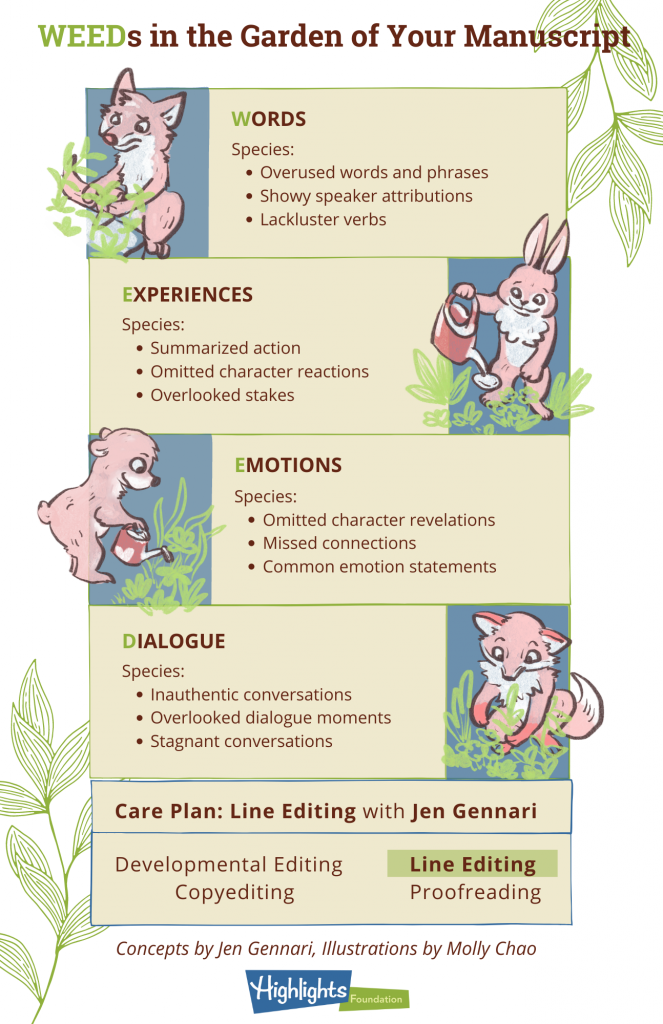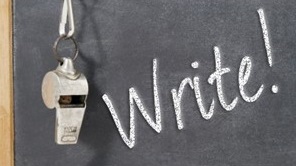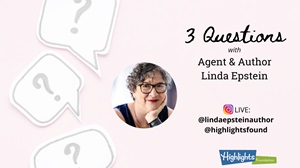Your book’s first editor is YOU
You’ve finished a manuscript! Celebrate your accomplishment, and get ready to revise. Perhaps you dread this step, envisioning the editor as someone who marks up your submission with a red pen or rejects your manuscript, squashing your dreams. But the first editor should not be someone else; your book’s first editor is you.
I’m a big fan of writers becoming strong self-editors. Building your editing skills requires understanding editorial feedback from others and studying the language in books you read. But how do you start? And what’s the difference between developmental editing, line editing, copyediting, and proofreading?
What’s the difference between developmental editing, line editing, copyediting, and proofreading?
Let’s picture your manuscript as a garden. Developmental editing is when you examine the plot and the characters to see if the story works. When you’ve established a solid story arc, you are ready to begin weeding at the line level. The goal of line editing is to make the writing clean and clear. You shape every paragraph, rethink every sentence, and review every word choice. When you are nearly ready for publication, two more editing phases happen: Copyediting checks grammar, facts, and sense, and proofreading fixes any errors. Although I’ve described this sequentially, the stages of editing can be repeated over and over.
I love line editing for the joy of smoothing transitions and tightening sentences, although some find it overwhelming. Weeding our manuscripts becomes manageable when we divide line editing into four parts: Words, Experiences, Emotions, and Dialogue.
Divide line editing into four parts: Words, Experiences, Emotions, and Dialogue (WEEDs).
Words:
Every editor has a list of overused words and phrases. You should make a list, too, and ruthlessly examine each time you use, for example, “just” or “smiled.” Can it be deleted? Is there a better word choice? What’s great about revising speaker attributions, verbs, and clichés is that you often uncover places in your manuscript where small changes have big impacts.
For example: She smiled as the butterfly flitted in her garden becomes As the monarch swooped over the daisies, she whispered a welcome to her garden guest.
Experiences:
What your character does drives your plot. Are there places in your manuscript where you’ve stated or summarized too much and missed a chance to show your character taking action? Review how your characters react and make decisions. This is a great way to make sure they’re struggling to reach their goal and that readers will experience it, too.
For example: At the sound of the bell, he walked to the front door wondering who it was becomes The doorbell zapped him to his feet, his heart hoping—ridiculously—that she was at his door.
Emotions:
Closely tied to experiences is how you express your protagonist’s feelings. Are emotions expressed through action and dialogue, not statements? Look for places where you want readers to deeply connect with your character, and revise to show your character’s reactions and inner thoughts. The emotional arc of your character should be revealed through what they say, do, and think.
For example: She felt her knees knock when the coach called her name becomes Coach’s shout cracked like an earthquake under her cleats.
Dialogue:
What your characters say in conversation should reveal who they are, what’s on their minds, and what they will do. Good dialogue should sound authentic, so look for places where the dialogue slows the pace of the story or if you’ve missed a chance to build conflict. Sometimes that means adding dialogue, shortening it, or changing it.
For example: “What’s in my lunch bag?” he asked becomes “What now?” He sniffed his sack lunch, the paper soft from reuse.
What I love about line editing is you are shaping what’s on the page to more closely match your vision for the story. As author Benjamin Dreyer wrote in Dreyer’s English, the work of line editing a manuscript is “to make it more of itself than it was before.” An editor or agent will notice the care you’ve taken with language, and will bring you closer to your publication dreams.
What If I’ve Already Done Some Revision, and I’m On a Later Draft?
During a workshop with Jennifer Gennari, one of the attendees asked if line editing/a course on line editing would be useful in revising a 3rd draft.
They said: “Working on my third draft now after recently finishing my second one. Is this a good time [for line editing]?”
Jen replied: …That’s perfect! The perfect time to join in.
I’ve actually seen a range; even people who are under contract taking [a line editing class] because they want a little extra help understanding the line editing notes they are getting back from their editors.
…I am such a word nerd, so we talk a lot about about language choices, down to the nitty gritty word level.








